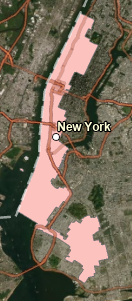Lab 1 Map Critique [GIS5007]: Well-designed vs. Poorly-designed Maps
Map Evaluation Synopsis:
Well-designed Map
This map meets its intended
aim to convey state-based and county-based information on the ancestry with the
largest population in the provided areas. Three design principles done
particularly well in this map include the following:
- Map Substantial Information (Tufteisms 1, 2, 3, 4, and 20)
- The cartographer has included a comprehensive set of ancestry labels for visualization at the state and county levels.
- Don’t Lie with Maps (Tufteisms 5, 6, 9, 10, 12, and 13)
- The cartographer has utilized the same scale in all maps with county-level data so accurate side-by-side comparisons between regions can be made.
- Map Layout Matters (Tufteism 19)
- The cartographer has effectively used the map real estate by placing map elements (e.g., the legend and data source information) in otherwise underutilized white space.
Finally, this map appeals to my cartographic aesthetic
based on the effective use of:
- visual contrast – distinguishable and contrasting set of category colors in the legend
- balance – good placement of map and associated map elements to minimize white space
- figure-ground organization – good choice to make U.S. region the most prominent by using gray color for bordering countries
--------------------------------------------------------------------------------------------------------------------
Map Evaluation Synopsis: Poorly-designed Map
This map does not meet
its intended aim to effectively convey hurricane path related information from 1851
to 2005. Three design
principles done particularly poorly in this map include the following:
- Map Substantial Information (Tufteisms 1, 2, 3, 4, and 20)
- The cartographer has failed to include any information on the map to assist with understanding the time frame indicated (1851-2005) for the various paths.
- Effectively Label Maps (Tufteisms 7 & 8)
- The cartographer has not included any labels to justify the coloring of continents; for example, if the desert in the upper portion of Africa has relevance to the how paths form just off the coast to the south of this region, then the yellow prominent coloring of the desert should be retained and labeled – otherwise, this coloring is a distraction.
- Map Layout Matters (Tufteism 19)
- The cartographer has failed to include essential map elements other than the main map.
Suggested improvements to
this map include the following:
- visual contrast – justify color choices for tracks and continents by adding appropriate legends
- legibility – add all essential map elements, ensuring relevant differences in the 1851-2005 time frame are appropriately highlighted (e.g., color by decade if relevant)
- balance – clip eastern side of Africa in final map and then balance the final layout with effective coverage of white space with map elements that contribute to interpretation
1





Comments
Post a Comment